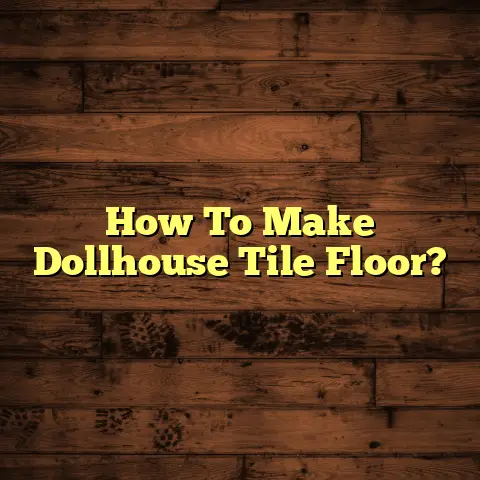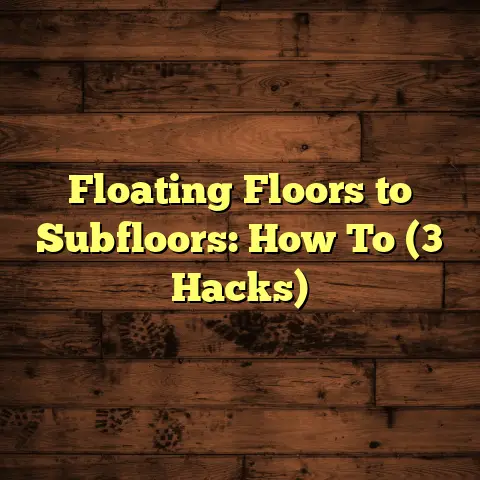Old Hardwood: Creative DIY Ideas? (3 Uses You’ll Regret!)
There’s something undeniably charming about old hardwood flooring, isn’t there?
The character, the history etched into every grain—it just screams potential for amazing DIY projects.
But before you grab that crowbar and start ripping up planks, let’s talk safety and smart choices.
Old hardwood, while beautiful, can also be a bit of a minefield.
We’re talking splinters that’ll make you see stars, potentially toxic finishes lurking beneath the surface, and structural weaknesses that could lead to disaster.
That’s why I wanted to write this article.
My goal here is to explore some truly creative ways to repurpose old hardwood, while also shining a spotlight on three specific uses that, trust me, you might seriously regret.
So, grab a cup of coffee, put on your safety goggles (metaphorically, for now!), and let’s dive in!
Section 1: Safety First
Alright, let’s get real.
Working with old hardwood isn’t the same as assembling that flat-pack furniture.
This is where we put on our safety hats (again, metaphorically… but maybe literally, too, if you’re clumsy like me!).
1. Understanding Hazards
Old hardwood has seen things, my friends.
It’s been through years of wear and tear, possibly decades of questionable cleaning products, and who knows what else.
-
Sharp Edges & Nails: First off, watch out for sharp edges, splinters, and those sneaky nails that love to hide just below the surface. I’ve lost count of the number of times I’ve caught myself on a rogue nail!
-
Chemical Treatments: Then there’s the potential for old finishes containing lead or other nasty chemicals. According to the EPA, homes built before 1978 are more likely to contain lead-based paint. That old varnish might look beautiful, but it could be a health hazard if you start sanding it without proper precautions.
-
Dust Inhalation: And let’s not forget the dust! Sanding or cutting old wood releases particles that can irritate your lungs and even cause long-term respiratory problems.
Think silica dust from old grout or asbestos fibers if you’re dealing with REALLY old materials.
Not fun.
2. Personal Protective Equipment (PPE)
Okay, so we know what we’re up against.
Now, let’s gear up!
Think of PPE as your superhero costume for DIY projects.
Here’s the breakdown:
-
Gloves: Protect your hands from splinters, chemicals, and general grime.
I prefer heavy-duty work gloves for handling rough planks and chemical-resistant gloves if you’re dealing with finishes or cleaning products.
-
Safety Goggles: These are non-negotiable. Dust, debris, and flying projectiles can seriously damage your eyes.
Make sure your goggles fit snugly and provide good peripheral vision.
I’ve had close calls where a stray wood chip would have blinded me if I wasn’t wearing goggles.
-
Masks/Respirators: For sanding, cutting, or anything that creates dust, a proper mask is crucial.
A basic dust mask is better than nothing, but for serious protection, invest in a respirator with replaceable filters.
Look for a NIOSH-approved respirator with an N95 or higher rating.
Trust me, your lungs will thank you.
-
Knee Pads: If you’re spending a lot of time on your knees, installing or working with flooring, knee pads are a lifesaver.
They’ll prevent soreness and protect your joints from long-term damage.
3. Workspace Preparation
A safe workspace is a happy workspace.
Here are some tips for setting up your DIY zone:
-
Ventilation: Open windows and doors to ensure proper ventilation.
If you’re working indoors, consider using a portable air purifier to remove dust and fumes.
-
Lighting: Good lighting is essential for seeing what you’re doing and avoiding accidents.
Use a combination of overhead lighting and task lighting to illuminate your work area.
-
Organization: Keep your tools organized and within easy reach.
A cluttered workspace is a dangerous workspace. Use toolboxes, pegboards, and shelves to keep everything in its place.
-
Stability: Make sure the flooring and surrounding areas are stable.
If you’re working on a raised platform, ensure it’s sturdy and can support your weight and the weight of your materials.
4. Proper Tool Usage
Tools are your friends, but they can also be your enemies if you don’t treat them with respect.
Here are some tips for using common DIY hardwood tools safely:
-
Saws: Whether you’re using a hand saw, circular saw, or jigsaw, always follow the manufacturer’s instructions.
Wear safety goggles and ear protection, and keep your fingers away from the blade.
Use clamps to secure the wood you’re cutting and avoid cutting freehand.
-
Sanders: Sanders create a lot of dust, so always wear a mask or respirator.
Start with a coarse grit sandpaper and gradually move to finer grits.
Keep the sander moving to avoid gouging the wood.
-
Drills/Drivers: Use the correct drill bit or driver bit for the job.
Apply steady pressure and avoid forcing the tool.
If you’re drilling into hardwood, pre-drill a pilot hole to prevent the wood from splitting.
-
Hand Tools: Don’t underestimate the importance of hand tools like hammers, chisels, and screwdrivers.
Use the right tool for the job and keep them sharp.
Always strike squarely and avoid glancing blows.
Section 2: Creative DIY Ideas for Old Hardwood
Okay, now for the fun part!
Let’s explore some creative ways to breathe new life into that old hardwood.
1. Idea 1: Rustic Furniture
There’s something undeniably charming about rustic furniture made from reclaimed materials.
Transforming old hardwood into tables, benches, or even headboards can add a touch of character to any space.
-
Design Considerations: Think about the overall aesthetic you’re going for.
Do you want a rough-and-tumble, heavily distressed look, or something a bit more refined?
Consider the size and shape of the hardwood you have available and design your furniture accordingly.
-
Potential Challenges: One of the biggest challenges is ensuring the furniture is structurally sound.
Old hardwood may have knots, cracks, or warping that can compromise its strength.
Use strong joinery techniques like mortise-and- tenon joints or dovetail joints to create a solid frame.
Reinforce weak areas with metal brackets or additional supports.
-
Ensuring Structural Soundness: Don’t be afraid to overbuild! It’s better to have a piece of furniture that’s slightly over-engineered than one that collapses under its own weight.
Use high-quality screws and construction adhesive to secure all joints.
Test the stability of the furniture by applying weight and pressure to different areas.
Example: I once built a coffee table using reclaimed oak flooring from a local schoolhouse.
I used a combination of mortise-and-tenon joints and metal brackets to create a sturdy base.
I then topped it with a thick slab of the oak flooring, carefully arranged to showcase the wood’s unique grain patterns and imperfections.
The result was a one-of-a-kind coffee table that became a focal point in my living room.
2. Idea 2: Wall Art or Decor
If you’re not quite ready to tackle a full-blown furniture project, creating wall art or decorative pieces from old hardwood is a great way to express your creativity.
-
Creativity & Design Tips: The possibilities are endless! You can create geometric patterns, abstract designs, or even realistic landscapes using different pieces of hardwood.
Consider incorporating other materials like metal, glass, or fabric to add visual interest.
Experiment with different textures and finishes to create a unique look.
-
Finishing Techniques: Once you’ve created your masterpiece, it’s time to finish it.
You can use stains, paints, or varnishes to enhance the wood’s natural beauty or create a more dramatic effect.
Consider using a clear coat to protect the wood from moisture and UV damage.
If you’re using reclaimed wood, you may want to leave some of the original imperfections visible to add character.
Example: I once created a wall hanging using various pieces of reclaimed hardwood flooring.
I arranged them in a mosaic pattern, creating a textured and visually interesting piece of art.
I then stained the wood in different shades of brown and gray to highlight the variations in grain and color.
The finished piece added a touch of rustic charm to my dining room.
3. Idea 3: Garden Planters
For the green thumbs out there, using old hardwood for outdoor garden planters is a fantastic way to add some character to your garden.
-
Design Ideas: You can build simple, rectangular planters or get more creative with tiered planters, raised beds, or even vertical gardens.
Consider the size and shape of the plants you want to grow and design your planters accordingly.
Add decorative elements like lattice panels, trellises, or even small benches to create a more inviting space.
-
Weatherproofing: The biggest challenge with using wood outdoors is protecting it from the elements.
Apply a sealant to the wood to protect it from moisture.
Line the inside of the planter with plastic to prevent the soil from coming into direct contact with the wood.
Consider using pressure-treated wood for the base of the planter to prevent rot.
-
Wood Decay: Even with proper weather- proofing, wood will eventually decay over time.
Inspect your planters regularly for signs of rot or insect damage.
Replace any damaged pieces of wood as needed.
Consider using naturally rot-resistant woods like cedar or redwood for your planters.
Example: I built a raised garden bed using reclaimed cedar fencing.
I lined the inside of the bed with plastic and filled it with a mixture of compost and topsoil.
I then planted a variety of herbs and vegetables, creating a thriving garden right outside my back door.
Section 3: 3 Uses You’ll Regret
Alright, let’s talk about the dark side of DIY.
Sometimes, even with the best intentions, certain projects just aren’t worth the hassle.
Here are three uses for old hardwood that you might seriously regret:
1. Regretful Use 1: Flooring Repairs
It might seem logical to use old hardwood to patch up damaged areas in your existing flooring, but trust me, this can be a recipe for disaster.
-
Structural Integrity: Old hardwood may be weakened by age, moisture, or insect damage.
Using it to repair flooring can compromise the structural integrity of the entire floor.
You might end up with soft spots, squeaks, or even complete failures.
-
Compatibility Issues: Even if the old hardwood is in good condition, it might not be compatible with your existing flooring.
Different species of wood have different densities and expansion rates.
Mixing them can lead to uneven surfaces, gaps, or buckling.
-
Mismatched Aesthetics: Even if you can find a piece of old hardwood that’s the same species as your existing flooring, it might not match the color or grain pattern.
This can create an unsightly patch that detracts from the overall appearance of the floor.
Alternative: If you need to repair your hardwood flooring, it’s best to use new hardwood that matches the existing flooring as closely as possible.
Consult with a flooring professional to ensure the repair is done properly.
2. Regretful Use 2: Kitchen Countertops
I know, I know, a rustic hardwood countertop sounds incredibly charming.
But in reality, using old hardwood for kitchen countertops is a maintenance nightmare and a hygiene hazard.
-
Maintenance Challenges: Wood is porous and absorbent, making it difficult to keep clean and sanitary.
Spills and stains can easily penetrate the wood, leading to discoloration and odors.
You’ll need to seal the countertop regularly with a food-safe finish to protect it from moisture and bacteria.
-
Hygiene Concerns: Wood is a breeding ground for bacteria.
Cutting boards made of wood are great for their self-healing properties, however, food particles can get trapped in the grain, leading to contamination.
Using old hardwood for kitchen countertops can increase your risk of foodborne illness.
-
Common Pitfalls: One of the biggest pitfalls is using the wrong type of wood.
Softwoods like pine are too porous and easily damaged.
Even hardwoods like oak and maple can be problematic if they’re not properly sealed and maintained.
Alternative: If you want the look of wood in your kitchen, consider using butcher block countertops.
Butcher block is made from strips of hardwood that are glued together to create a durable and water-resistant surface.
3. Regretful Use 3: DIY Shelving
Building shelves from old hardwood might seem like a simple and cost-effective project, but it can lead to serious problems if not done correctly.
-
Load-Bearing Capacity: Old hardwood may be weakened by age, moisture, or insect damage, reducing its load-bearing capacity.
Overloading the shelves can cause them to sag, bow, or even collapse.
-
Stability: Shelves need to be properly supported to prevent them from tipping or falling.
Using flimsy brackets or improperly installed supports can lead to accidents or damage.
-
Risks of Improper Construction: One of the biggest risks is using the wrong type of fasteners.
Screws that are too short or too thin may not provide enough holding power.
Nails can also pull out over time, especially if the wood is dry or brittle.
Alternative: If you need to build shelves, use new lumber that is properly sized for the load you plan to carry.
Use sturdy brackets and install them securely into wall studs.
Conclusion
So, there you have it!
A look at the exciting possibilities and potential pitfalls of working with old hardwood.
The key takeaway here is balance.
Embrace the creativity, but never compromise on safety.
Careful planning and consideration are essential to avoid those DIY regrets.
Before you start any project, take the time to assess the condition of the wood, gather the necessary safety equipment, and research the best techniques.
And remember, it’s always better to err on the side of caution.
Don’t be afraid to ask for help from a professional if you’re unsure about anything.
With a little bit of knowledge and preparation, you can transform old hardwood into beautiful and functional pieces that you’ll be proud of for years to come.
Happy DIY-ing, and stay safe out there!





